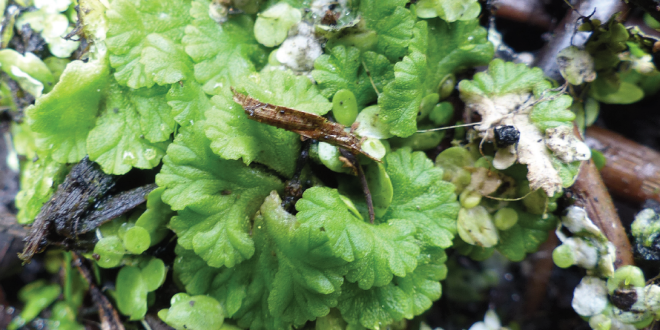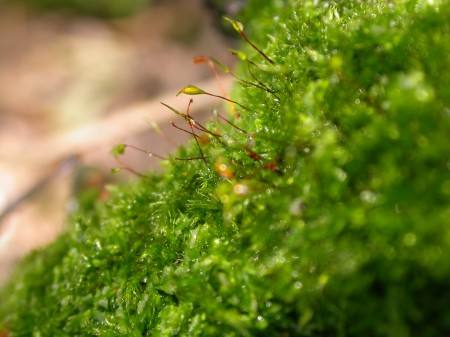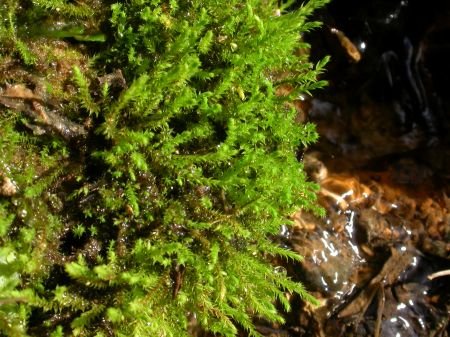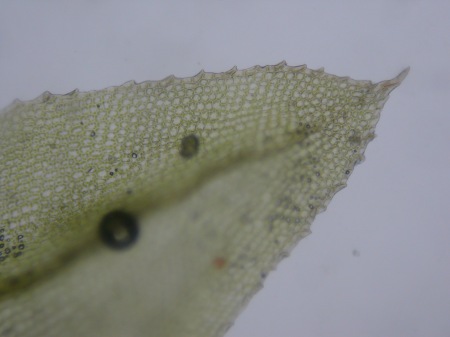Source: Adastra 2015, published by the Sussex Biodiversity Record Centre, February 2016
It’s been a very busy year with many noteworthy finds and thus hard to decide which to mention here. It’s always satisfying to refind species that were known to earlier bryologists but which haven’t been seen for a long time. One such liverwort was Leiocolea badensis which was seen by Jean Paton when she did a lot of work in Sussex back in the 1950s. After much searching it was eventually relocated in probably the same chalk quarry that she knew it from, near Plumpton, and there’s plenty of it there too. An even older record of Aloina rigida, discovered by Nicholson around 1900 from Southerham near Lewes, also took many visits to refind but there’s actually a strong colony there still and quite possibly in the same locality that he knew it from. Other ‘refinds’ of old records have included Weissia condensa from Mount Caburn and Ricciocarpus natans from the Knepp Castle Estate where it is to be found in the main lake along with our only other floating bryophyte, Riccia fluitans. Knepp has many special bryophytes.
Other species are spreading into Sussex. One example of this is the small pleurocarp, Sematophyllum substrumulosum. Although known for many years in Kingley Vale where it is to be found on Yew branches, in 2014 it was found on decorticated conifer logs in Ashdown Forest by Sam Bosanquet. Subsequent searches in coniferous woodland in East Sussex and further records from West Sussex have resulted in it now being recorded from 20 tetrads in the county. Exactly when it first colonised is hard to work out because the habitat in which it grows is rarely visited by bryologists since, apart from this rarity, only a few very common species are likely to be seen. It doesn’t appear to be too choosy about which conifer’s logs it lives on but they do need to be in quite a damp wood so a clay soil helps. It looks like a small Hypnum but with nearly straight leaves. The capsules look just like those of Rhynchostegium confertum although are actually not much more than half the size.
Some species appear to have declined quite rapidly in our county. This can be for a number of reasons but habitat loss is very often implicated and that could be due to a reduction in grazing or an increase in air pollution (particularly nitrogen dioxide, recently much in the news) or both. Philonotis fontana, a common moss of flushes in upland Britain, was apparently frequently seen 100 years ago but is now known from just one site in the county at Newbridge Bog on Ashdown Forest. Even there it is very rare but at least recent conservation work means it has a chance of surviving, now a lot of the encroaching scrub has been removed. It also used to be found on Colhook Common north of Petworth but the shallow pool from where it was known is now just a willow thicket. A notable loss from the county has been Acaulon triquetrum, one of Britain’s rarest mosses. The cliff-top where it could be found up until just 2 years ago is now increasingly becoming invaded by long grass.
During the year, some exceptional sites have been surveyed. Apart from Knepp mentioned above, these include Botany Bay near Duncton, now well looked after and home to some very nice chalk stream bryophytes. Mention should also be made of Bignor Park where another chalk stream has excellent colonies of several rare mosses including Mnium stellare, a very attractive moss of damp calcareous places. Bignor has many diverse habitats and consequently a long list of mosses and liverworts. A remarkable site, apparently previously overlooked, is in Hadlow Down in East Sussex. An ancient Chestnut coppice has sheets of both species of Leucobryum, fruiting abundantly which is in itself very unusual. Many of the stools also have dense patches of the liverwort, Barbilophozia attenuata and there are rare species of Dicranum there too. Much of Bognor Common is now a sandstone quarry but around the edges there are some interesting mosses including both Ditrichum pusillum and D. heteromallum, both in some abundance. A fine colony of the large thallose liverwort, Blasia pusilla, is at its only extant location in the county and numerous patches of the fascinating Fossombronia incurva are dotted around. The leafy liverwort, Lophozia excisa, is abundant over huge areas.
The genus Orthotrichum continues to receive attention. Sussex is in the firing line for spores that manage to cross the Channel and we will continue to have a good chance of finding odd tufts of real rarities. This year a single tuft of O. speciosum was found on Ashdown Forest (in last year’s Adastra review I reported that O. rogeri had been found only 1km away). O. pallens then turned up in a small colony of about 5 tufts in the middle of a hedge at Blackboys having also been recorded from West Sussex in 2014. There are still 3 or 4 species of the genus that could quite possibly be established somewhere in the county so the hunt goes on.
Very recently, a visit to woodland near Crowborough resulted in only the sixth record for the liverwort, Scapania curta in the country in the last 25 years and also a moss completely new for Sussex. The Scapania used to be recorded occasionally on damp sandy rides in the Weald but it’s small and tricky to identify and once Jean Paton left the county the records seemed to dry up. The good news is that it’s still there and should be looked for, particularly in woodland on north facing slopes on sandy soils. At Crowborough it grows with Archidium alternifolium whereas at another recent site for it, Hindleap Warren, it is associated with Riccia subbifurca, another sandy soil specialist. The new moss was Atrichum crispum, growing on a stream bank. Apart from a probable introduction at Wisley this has a very western and northern distribution in Britain. It’s an attractive moss and a welcome addition to our flora but easily overlooked since it can superficially resemble the very common Funaria hygrometrica. It is unlikely to be mistaken for other species of Atrichum however.
Bryum creberrimum was found on a gravel track in woodland in East Sussex. It is part of a difficult group of species to identify and required a specimen being sent to the expert for the genus, David Holyoak, who now lives in Portugal. That was the first confirmed record in the county since 1902 and complements several other rare species of Bryum being spotted including B. donianum and B. sauteri. It still leaves a few to find however and a determined search is currently in progress for two of the rare species of chalk downland, B. kunzei and B. canariense, neither of which have been seen in the county for many years now.
Another very rare moss search is also in progress, this time for Atrichum angustatum. It was known from a few sites in Sussex and numerous places in Kent but has inexplicably and rapidly declined to the extent that it has not been seen in either county for the last 14 years. All the last-known sites for it are being revisited in the hope that it can be found and conserved, so far without success but by this time next year it might hopefully have been rediscovered.




A few sequels are probably worth adding. It turned out there was quite a lot of the Ricciocarpus at Knepp but I gather the lake was going to be dredged at some point. I expect it will have survived though and it’s a very attractive liverwort. Scapania curta has been refound in Kent by Stephen Lemon. Sematophyllum was found in even more sites after this piece was written. It’s found in many counties now. The Atrichum crispum was almost certainly incorrect as immature A. undulatum can look very similar. The easiest distinction is that A. crispum has papillae on the cuticle on the marginal teeth. When well-grown, A. crispum looks quite different and is perhaps unlikely to turn up in Sussex. Bryum kunzei was searched for many times without success but it’s a small moss and could still be there. B. canariense is more likely to be refound and I know is being looked for by Sue. Finally, Atrichum angustatum was eventually refound, in Kent but has obviously declined greatly in recent years for some reason.
LikeLiked by 2 people